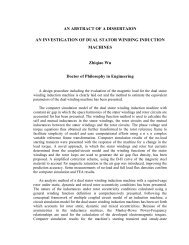CLIFFORD AND GRASSMANN HOPF ALGEBRAS VIA THE ...
CLIFFORD AND GRASSMANN HOPF ALGEBRAS VIA THE ...
CLIFFORD AND GRASSMANN HOPF ALGEBRAS VIA THE ...
Create successful ePaper yourself
Turn your PDF publications into a flip-book with our unique Google optimized e-Paper software.
to assure functionality of BIGEBRA:<br />
> restart:with(Clifford):with(linalg):with(Bigebra);<br />
[&cco, &gco, &gco d, &gco pl, &map, &v, EV , VERSION , bracket, contract,<br />
drop t, eps, gantipode, gco unit, gswitch, hodge, linop, linop2 , lists2mat,<br />
lists2mat2 , make BI Id, mapop, mapop2 , meet, op2mat, op2mat2, pairing,<br />
peek, poke, remove eq, switch, tcollect, tsolve1 ]<br />
The output is a list with available functions; some of them are for internal use<br />
only. <strong>CLIFFORD</strong> and BIGEBRA come with an extensive online help page system<br />
which is included in the Maple online help and can be searched. It contains<br />
not only the syntax of the procedures but even a good deal of unpublished<br />
mathematics. It is meant to present to the user the mathematical concepts<br />
at hand. Help topics may be reached in Maple fashion with the command<br />
?Bigebra followed by the enter key.<br />
2.1 Tensor product<br />
Given the functionality of <strong>CLIFFORD</strong> to compute with Clifford algebras, we<br />
need two more key features to enter the realm of bi- and Hopf algebras. The<br />
first one is the tensor product and some functions to manipulate it with while<br />
the second is the coproduct. The latter, however, follows naturally from the<br />
algebra structure on the linear dual space [16].<br />
Maple comes with a define facility whose function is to introduce ampersand<br />
operators & that are associative (flat), commutative (orderless), linear<br />
or multilinear. This facility unfortunately has two drawbacks:<br />
• It cannot deal with user-defined scalars (ring elements). This is mathematically<br />
insensitive since any definition of a linear or multilinear function must<br />
include a linearity with respect to “scalars” that one wants to compute<br />
with. For example, we want to consider multilinear and associative tensor<br />
products over arbitrary rings such as the integers, polynomial rings etc.<br />
• It produces code which gives wrong output.<br />
Therefore, BIGEBRA comes with its own define procedure. Remembering that<br />
Graßmann basis multivectors are denoted as Id, e1, e2, ei, e1we2, e1we3,<br />
eiwej,..., let us explore properties of the associative (flat) multilinear operators<br />
&t and &r (comments in the code are separated by #).<br />
In <strong>CLIFFORD</strong> and BIGEBRA almost everything can be treated as scalars, hence<br />
one can compute over function spaces etc. A generic tensor product of BIGEBRA<br />
is given by &t.<br />
> out[1]:=e1+e2 &t e3, &t(e1+e2,e3):<br />
> out[2]:=&t(&t(-e1)):<br />
4
















